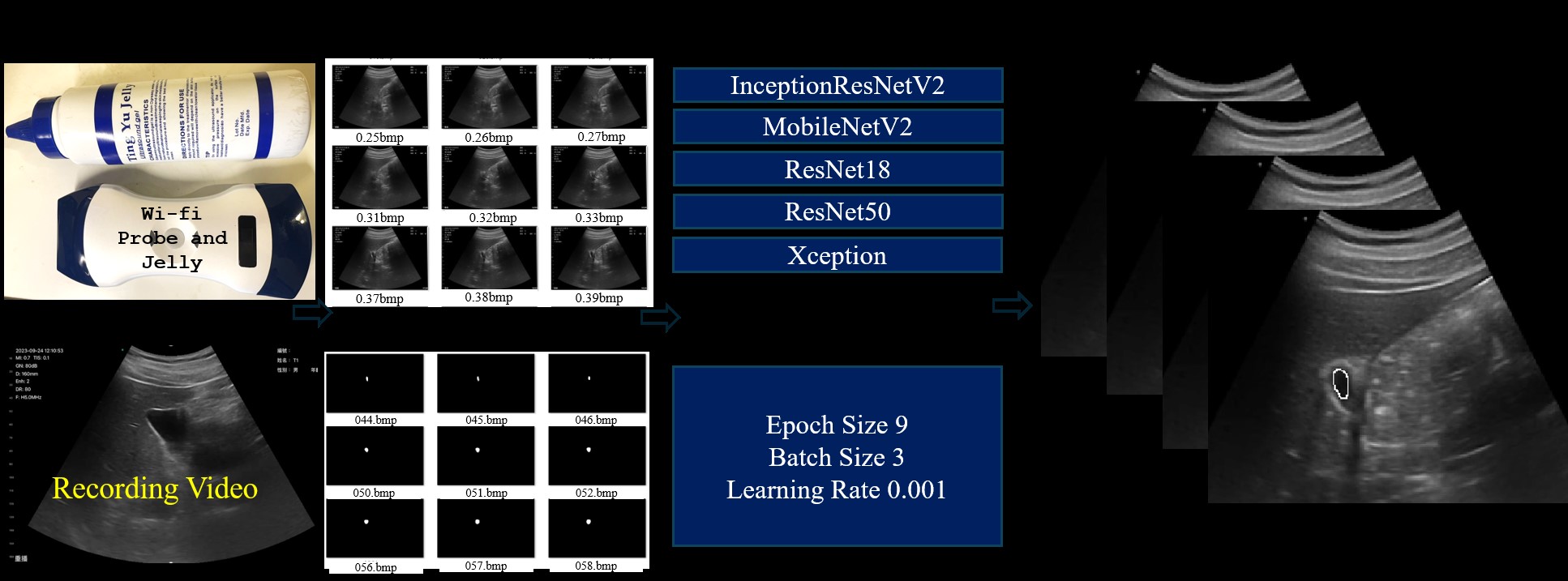Advanced Gallbladder Segmentation in Dynamic Ultrasound Imaging Using Fully Convolutional Networks
DOI:
https://doi.org/10.46604/emsi.2024.13650Keywords:
FCN, Dynamic B-mode Ultrasound, Wi-Fi Probe, Ultrasound Gallbladder ImageAbstract
This study develops an advanced technique for segmenting the gallbladder from dynamic B-mode ultrasound images to enhance the accuracy and efficiency of volumetric analysis in medical diagnostics. Using a Wi-Fi probe, volumetric data are captured and processed into labeled images for training a fully convolutional network (FCN) model with specifications including an epoch of 9, a batch size of 3, and a learning rate of 0.001. Performance metrics such as global accuracy, mean accuracy, and Intersection over Union (IoU) are evaluated. The MobileNetV2 architecture achieves a maximum mean IoU of 0.690 and a mean Boundary F1 (BF) score of 0.990, while the ResNet50 architecture demonstrates significant effectiveness. This study substantiates the effectiveness of the MobileNetV2 architecture for precise gallbladder segmentation in dynamic B-mode ultrasound imaging.
References
M. Zhuo, X. Chen, J. Guo, Q. Qian, E. Xue, and Z. Chen, “Deep Learning-Based Segmentation and Risk Stratification for Gastrointestinal Stromal Tumors in Transabdominal Ultrasound Imaging,” Journal Ultrasound in Medicine, in press. https://doi.org/10.1002/jum.16489.
X. Jia, X. Li, T. Shen, L. Zhou, G. Yang, F. Wang, et al., “Monitoring of Thermal Lesions in Ultrasound Using Fully Convolutional Neural Networks: A Preclinical Study,” Ultrasonics, vol.130, article no. 106929, April 2023.
B. He, S. Zhao, Y. Dai, J. Wu, H. Luo, J. Guo, et al., “A Robust and Automatic CT-3D Ultrasound Registration Method Based on Segmentation, Context, and Edge Hybrid Metric,” Medical Physics, vol. 50, no. 10, pp. 6243-6258, October 2023.
V. T. Hoang, H. A. T. Van, T. T. T. Nguyen, V. Chansomphou, and C. T. Trinh, “Diffuse Gallbladder Adenomyomatosis with an Inflammatory Complication in an Adult,” Case Reports in Gastroenterology, vol. 15, no. 1, pp. 100-107, January-April 2021.
R. Jin, M. Wang, L. Xu, J. Lu, E. Song, and G. Ma, “Automatic 3D CT Liver Segmentation Based on Fast Global Minimization of Probabilistic Active Contour,” Medical Physics, vol. 50, no. 4, pp. 2100-2120, April 2023.
J. Mitra, C. Bhushan, S. Ghose, D. Mills, A. Patel, H. Chan, et al., “A Hybrid Deformable Registration Method to Generate Motion-Compensated 3D Virtual MRI for Fusion with Interventional Real-Time 3D Ultrasound,” International Journal of Computer Assisted Radiology and Surgery, vol. 18, no. 8, pp. 1501-1509, August 2023.
Z. Szentimrey, S. de Ribaupierre, A. Fenster, and E. Ukwatta, “Automated 3D U-Net Based Segmentation of Neonatal Cerebral Ventricles from 3D Ultrasound Images,” Medical Physics, vol. 49, no. 2, pp. 1034-1046, February 2022.
Y. Chen, L. Xing, L. Yu, W. Liu, B. P. Fahimian, T. Niedermayr, et al., “MR to Ultrasound Image Registration with Segmentation-Based Learning for HDR Prostate Brachytherapy,” Medical Physics, vol. 48, no. 6, pp. 3074-3083, June 2021.
M. F. Azampour, M. Tirindelli, J. Lameski, M. Gafencu, E. Tagliabue, E. Fatemizadeh, et al., “Anatomy-Aware Computed Tomography-to-Ultrasound Spine Registration,” Medical Physics, vol. 51, no. 3, pp. 2044-2056, March 2024.
J. Zhang, T. Fu, Y. Wang, J. Li, D. Xiao, J. Fan, et al., “An Alternately Optimized Generative Adversarial Network with Texture and Content Constraints for Deformable Registration of 3D Ultrasound Images,” Physics in Medicine and Biology, vol. 68, no. 14, article no. 145006, July 2023.
T. Murabayashi, R. Matsushima, and S. Sugimoto, “Novel Technique of Additional Anchor Plastic Stent Placement during Endoscopic Ultrasound-Guided Gallbladder Drainage,” Endoscopy, vol. 56, no. 1, pp. 283-284, December 2024.
T. Okuzono and K. I. Miyamoto, “Novel Anchoring Device for Endoscopic Ultrasound-Guided Gallbladder Drainage: Secondary Publication,” Journal of Hepato-Biliary-Pancreatic Sciences, vol. 29, no. 7, pp. 825-831, July 2022.
K. Iwano, T. Hayashi, and A. Katanuma, “Successful Re-Intervention of Endoscopic Ultrasound-Guided Gallbladder Drainage Using a Dual-Channel Endoscope,” Digestive Endoscopy, vol. 34, no. 6, pp. 143-144, September 2022.
K. G. Foley, M. J. Lahaye, R. F. Thoeni, M. Soltes, C. Dewhurst, S. T. Barbu, et al., “Management and Follow-Up of Gallbladder Polyps: Updated Joint Guidelines Between the ESGAR, EAES, EFISDS and ESGE,” European Radiology, vol. 32, no. 5, pp. 3358-3368, May 2022.
S. W. van der Merwe, R. L. J. van Wanrooij, M. Bronswijk, S. Everett, S. Lakhtakia, M. Rimbas, et al., “Therapeutic Endoscopic Ultrasound: European Society of Gastrointestinal Endoscopy (ESGE) Guideline,” Endoscopy, vol. 54, no. 2, pp. 185-205, December 2022.
A. Kamaya, C. Fung, J. L. Szpakowski, D. T. Fetzer, A. J. Walsh, Y. Alimi, et al., “Management of Incidentally Detected Gallbladder Polyps: Society of Radiologists in Ultrasound Consensus Conference Recommendations,” Radiology, vol. 305, no. 2, pp. 277-289, November 2022.
T. Kim, Y. H. Choi, J. H. Choi, S. H. Lee, S. Lee, and I. S. Lee, “Gallbladder Polyp Classification in Ultrasound Images Using an Ensemble Convolutional Neural Network Model,” Journal of Clinical Medicine, vol. 10, no. 16, article no. 3585, August 2021.
S. T. Hsu, Y. J. Su, C. H. Hung, M. J. Chen, C. H. Lu, and C. E. Kuo, “Automatic Ovarian Tumors Recognition System Based on Ensemble Convolutional Neural Network with Ultrasound Imaging,” BMC Medical Informatics and Decision Making, vol. 22, article no. 298, 2022.

Published
How to Cite
Issue
Section
License
Copyright (c) 2024 You-Jie Chen, Tai-Been Chen, Wen‑Hung Twan

This work is licensed under a Creative Commons Attribution-NonCommercial 4.0 International License.
Copyright Notice
Submission of a manuscript implies: that the work described has not been published before that it is not under consideration for publication elsewhere; that if and when the manuscript is accepted for publication. Authors can retain copyright in their articles with no restrictions. Also, author can post the final, peer-reviewed manuscript version (postprint) to any repository or website.
Since Sep. 01, 2023, EMSI will publish new articles with Creative Commons Attribution Non-Commercial License, under Creative Commons Attribution Non-Commercial 4.0 International (CC BY-NC 4.0) License.
The Creative Commons Attribution Non-Commercial (CC-BY-NC) License permits use, distribution and reproduction in any medium, provided the original work is properly cited and is not used for commercial purposes.





